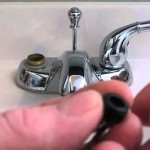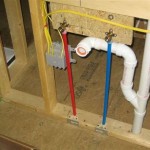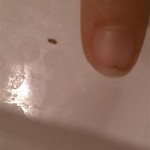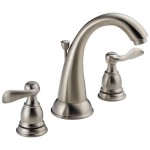Bathroom Sink Faucet Does Not Turn Off
A bathroom sink faucet that does not turn off completely can be a frustrating and wasteful problem. It can lead to a constant drip, flooding, and even damage to your bathroom. The good news is that in many cases, the problem can be solved with a few simple repairs. This article will guide you through identifying the common causes and providing practical solutions to fix a bathroom sink faucet that won't fully shut off.
Common Causes of a Non-Shutting Bathroom Sink Faucet
There are several reasons why a bathroom sink faucet might not turn off completely. Understanding the root cause is crucial for selecting the appropriate repair method.
1. Worn-Out O-Rings and Washers
O-rings and washers are small rubber or plastic components that create seals within the faucet. Over time, these components can wear out, become brittle, or crack, leading to leaks and a failure to fully shut off the water flow.
2. Mineral Buildup and Sediment
Hard water can lead to mineral buildup within the faucet's internal mechanisms. This accumulation of calcium and magnesium deposits restricts water flow and can impede the proper functioning of the faucet's valve.
3. Loose or Damaged Valve Stem
The valve stem is a crucial component that controls the water flow. If the stem becomes loose or damaged, it may not fully engage with the seat, resulting in a leak or incomplete shut-off.
4. Worn-Out Cartridge
Some faucets utilize a cartridge, a single unit containing multiple components. Cartridges can wear out over time, causing leaks and other issues, including the inability to completely turn off the water flow.
5. Improper Installation
Sometimes, a bathroom sink faucet may not function correctly due to improper installation. This can include issues with the faucet's mounting, the connection of the supply lines, or the alignment of the internal components.
Troubleshooting and Repair Solutions
Once you have identified the potential cause, you can start to resolve the issue. Here are some steps to troubleshoot and repair a bathroom sink faucet that does not turn off.
1. Check for Loose Connections
Begin by checking the connections under the sink. Make sure the supply lines are securely tightened to the faucet and the shut-off valves are fully closed. If any connections appear loose, tighten them using a wrench. Make sure to avoid overtightening, which can damage the components.
2. Clean the Aerator
The aerator is the small screen-like component at the end of the faucet spout. Mineral buildup can clog the aerator, reducing water flow and causing leaks. To clean the aerator, unscrew it from the faucet and soak it in vinegar for a few hours. Then, scrub the aerator with a small brush and rinse it thoroughly. Reinstall the aerator and check if the faucet is fully shutting off.
3. Replace Worn-Out O-rings and Washers
If the issue persists, you may need to replace the O-rings and washers. Turn off the water supply to the faucet, disassemble the faucet according to the manufacturer's instructions, and inspect the O-rings and washers for wear and tear. Replace any damaged components with new ones. Ensure that the replacement O-rings and washers are compatible with your specific faucet model. Reassemble the faucet, turn the water back on, and test for leaks.
4. Clean the Faucet Valve
Mineral buildup can also affect the faucet valve's ability to seal properly. To clean the valve, turn off the water supply and disassemble the faucet according to the manufacturer's instructions. Remove the valve stem and clean it thoroughly with vinegar or a specialized cleaning solution. Use a small brush to remove any mineral deposits. Reassemble the faucet after cleaning and test for leaks.
5. Replace the Cartridge
If cleaning the valve fails to resolve the issue, you may need to replace the cartridge. Consult the faucet's manufacturer instructions for guidance on replacing the cartridge. Ensure you purchase a cartridge that is compatible with your specific faucet model.
6. Consider Professional Help
If you are unable to identify and repair the issue or if the faucet requires specialized tools or knowledge, it is best to contact a qualified plumber for assistance. They can diagnose the problem accurately, perform the necessary repairs, and ensure that the faucet is working properly. A plumber can also advise you on the best course of action for your specific situation.
By following these troubleshooting steps and repair solutions, you can address a bathroom sink faucet that does not turn off completely. Make sure to use caution when working with plumbing fixtures and refer to manufacturer instructions or professional help when needed. A properly functioning faucet will not only enhance your bathroom experience but also prevent unnecessary water waste and potential damage to your bathroom.

Faucet Won T Turn Off Tips From A Houston Plumber Santhoff Plumbing

Bathroom Sink Faucet Won T Stop Running Doityourself Com Community Forums

Why Is My Bathroom Sink Faucet Won T Turn Off Ysis And Fixing Process

My Kitchen Faucet Won T Turn Off

Bathtub Faucet Won T Turn Off What To Do Alpha Building Inspections

Tap Not Turning Off What Can I Do To Isolate The Water

Hot Water Faucet Won T Turn Off Because I Accidentally Left On During Stem Removal Terry Love Plumbing Advice Remodel Diy Professional Forum

Four Reasons Why Your Faucet Won T Stop Dripping Service Plus Plumbing

Bathtub Water Faucet Won T Turn Off

Replacing A Bathroom Faucet Fine Homebuilding
Related Posts







